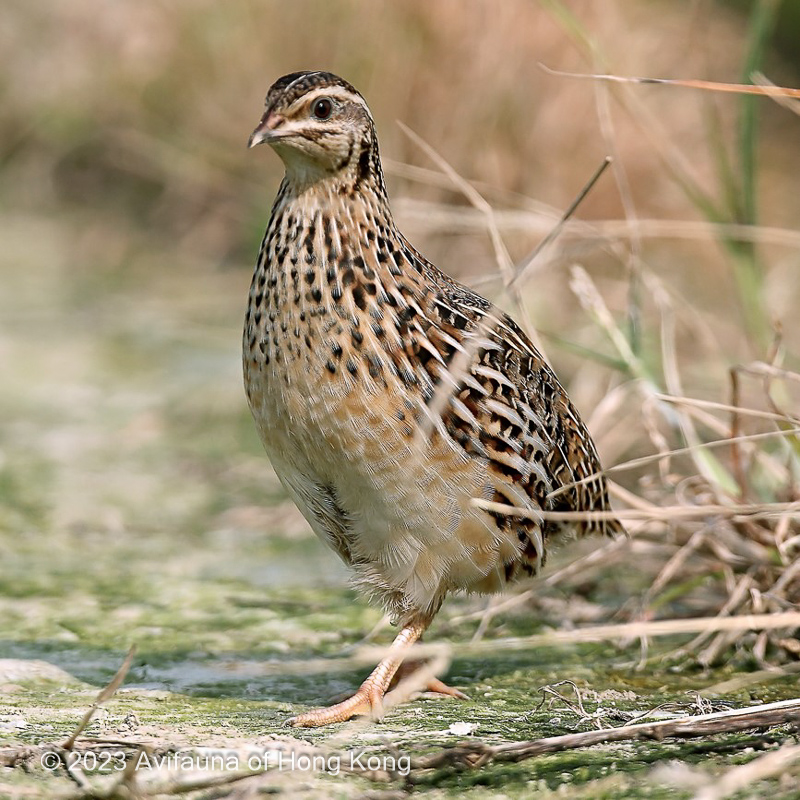Japanese Quail Coturnix japonica 鵪鶉
Category I. Scarce autumn migrant, rare winter visitor and spring migrant. Previously more numerous in spring and winter, and less numerous in autumn. Overall numbers may be lower than previously.
IDENTIFICATION

Oct. 2009, Michelle and Peter Wong.
17-19 cm. Small gamebird of open country habitats usually seen when flushed. Male has rufous face and throat with broad creamy supercilium and dark crown, and a buff tone to chest and flanks. Female is duller below with blackish mottling on chest, a less obvious supercilium and buff or whitish face and throat. Distinguished from buttonquails in flight by plain upper wings, slightly larger size and longer outer wing.
VOCALISATIONS
When flushed gives a whistled ‘trreeee’:
The song is very rarely heard in HK.
DISTRIBUTION & HABITAT PREFERENCE
Most records are from low-lying grassy areas in the northern New Territories at such sites as Long Valley, Mai Po, Kam Tin and commercial fish pond areas. There are also isolated reports from other widespread areas including Lantau and the offshore islands, the current airport at Chek Lap Kok and Sai Kung. Occasional urban area records may refer to disoriented migrants or possible ex-captive individuals.
OCCURRENCE
Most records of Japanese Quail are from the beginning of October to the end of February followed by a weak passage from March to the middle of May (Figure 1); the main period of occurrence is October to mid-November. Extreme dates are 18 September 2017 and 23 May 1979; in addition, one was picked up dead at the top of Tai Mo Shan on 25 May 1960.
Records on 9 September 1960 and in June are sufficiently far outside the normal period of occurrence as to cast doubt on the birds concerned having arrived naturally. Although La Touche (1931-34) does refer to occasional summer records in southern China, and even possible breeding, this species has long been reared for consumption.
Until 1998 the occurrence of Japanese Quail in HK was characterized by weak passage in autumn and strong passage in spring from the final week of March to the third week of April, which is the opposite of the pattern of records this century (Figure 1). It is possible that this change from a more even spread of records across the winter period with a moderate peak in spring to one whereby there is an obvious peak in autumn and rather low numbers at other times is related to global heating. If fewer birds now spend the winter near or south of HK, then numbers in spring would be lower and winter numbers higher.
Considerable year-on-year variation exists in numbers reported, and in some winters there are no records at all. Previously, totals of 100-200 birds were reported (e.g., 1959-60 and the mid-1990s); however, such high totals no longer occur. Typically, only one or two birds are reported at a single site, and the highest count this century is of seven on 28 October 2010. This compares with the situation in the 1990s when small groups of up to seven birds were often reported, with the maximum count after the mid-1980s being 15. This suggests that in tandem with a change in period of occurrence, there has also been a decline in reported numbers. However, long-term trends cannot be identified with confidence from submitted records due to a lack of systematic surveying and bias due to variations in observer effort. It is of note, however, that in Japan, Brazil (1991) referred to a marked decline during the first half of the 20th century because of hunting and, more recently, habitat loss, while Brazil (2018) referred to Japanese Quail as ‘now scarce’.
Vaughan and Jones (1913) considered this species to be abundant in some years and very scarce in others. Herklots (1967) noted that it was found commonly in April and October from sea level to above 600m on Ma On Shan and Tai Mo Shan but was less common than previously due to intensive netting in China.
BEHAVIOUR, FORAGING & DIET
Forages unobtrusively among grassy or rank grassy vegetation, presumably on plant materials, in particular seeds.
Shy and difficult to see, usually only coming out in the open when disturbed. When flushed it suddenly rises and flies low over ground on rapid wing beats before dropping back down into vegetation, at which point it usually runs immediately.
RANGE & SYSTEMATICS
Monotypic. Breeds from the Lake Baikal area east and southeast to Sakhalin, northeast China and northern Japan. Winters in the Korean peninsula, southern Japan, much of China south of the Yellow River, including Hainan, and northern Indochina west to western Myanmar.
Breeds in northeast China south to Hebei (Liu and Chen 2020), as far as Beijing on occasion (Birding Beijing 2021), and winters in much of the southern and central parts of the country.
CONSERVATION STATUS
IUCN: NEAR-THREATENED. Population trend suspected to be undergoing a moderately rapid decline due to hunting and agricultural changes.
Figure 1.

Birding Beijing (2021). https://birdingbeijing.com/the-status-of-the-birds-of-beijing/ (Accessed 24 November 2022).
Brazil, M. (2018). Birds of Japan. Helm, London.
Herklots, G. A. C. (1967). Hong Kong Birds (2nd ed.). South China Morning Post, Hong Kong.
La Touche, J. D. D. (1931-34). Handbook of the birds of Eastern China, Vol. 2. Taylor and Francis, London.
Vaughan, R. E. and K. H. Jones (1913). The birds of Hong Kong, Macao and the West River or Si Kiang in South-East China, with special reference to their nidification and seasonal movements. Ibis 1913: 17-76, 163-201, 351-384.
Liu, Y. and Y. H. Chen (2020). The CNG Field Guide to the Birds of China (in Chinese). Hunan Science and Technology Publication House, Changsha.

